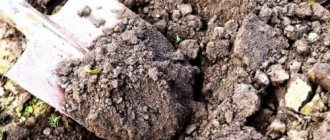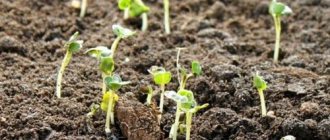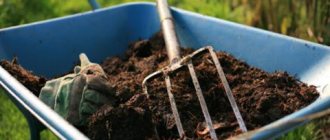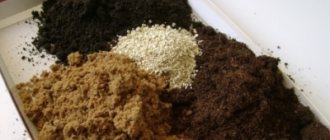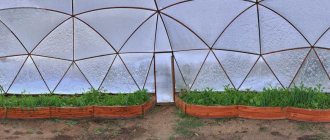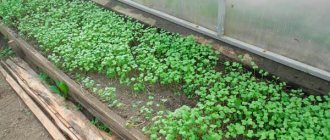After a busy summer season, I want to relax as soon as possible and, if possible, reduce the list of work. One of them - digging up the earth in the fall - was until recently carried out by all gardeners and was considered very important.
And now the question increasingly arises: is this really a necessary procedure, is it worth spending time and effort on it, or can you get by with just spring digging? So, let's finally find out whether it is necessary to dig up the garden in the fall and understand all the intricacies of this work.
Preparing beds in the fall for the new season is one of the most important conditions for obtaining a rich harvest. Over the winter, the soil is saturated with minerals that were added during digging. Snow saturates the beds with moisture faster, while the dug-up soil itself does not become compacted. As a result, in the spring it is much easier to carry out preparatory work before planting. Significantly save energy and time.
Digging up the earth for the winter
It is imperative to dig up your garden in the fall before the coming winter. This procedure is necessary to prepare the soil. In the autumn season, during the digging period, the ideal period begins for fertilizing with manure, composts and humus. Also, in farms where planted crops are regularly attacked by the Colorado potato beetle, mole cricket, wireworm and other types of pests, digging up the soil will be relevant. The procedure allows you to destroy the larvae hidden in the soil. To do this, plow the ground to a depth of 25 cm.
Choosing the right tool
If you want to know how to quickly dig up a vegetable garden, then thanks to this article you can find a lot of interesting things. Fortunately, our land on the Kulibins has not yet become impoverished; they are constantly inventing simple improvements for shovels or forks, with the help of which digging up the earth becomes not such a labor-intensive task for health.
Pitchfork.
For digging purposes, as a rule, forks are used - digging forks; they have shorter teeth and are forged. In addition, after the fork there are no large lumps of earth left that still need to be broken up. And part of the soil passes through their teeth and there will be no need to lift excess soil. Many new models have been invented based on forks, with which digging will be possible even for pensioners or people with disabilities.
For clay or damp soils, a pitchfork is just what you need. Excess soil will not stick to them, and it will be much easier to simply stick them into such soils. If the area is heavily overgrown, it is also better to choose a pitchfork for digging. They will go into the ground much easier, and the weeds will be pulled out along with the roots, rather than cutting them off like shovels. From the remains of these roots a new weed will certainly grow. And the pitchfork will remove it, as they say, “by the roots.”
When deep, two-tier digging with loosening the lower layers of the earth, a pitchfork is also indispensable. Still, simple pitchforks are good in small areas or in hard-to-reach corners, but for large spaces many devices based on them were invented, which we will talk about below.
Shovels.
Now we’ll learn how to quickly dig up a garden with a shovel. For better penetration into the soil, especially virgin soil, regular sharpening is required. And besides digging, a shovel will serve you when digging holes or ditches. But still, as a rule, after shoveling, you will need to further process the area with a pitchfork. And the most reliable shovel option is a titanium one, especially on clay, virgin or rocky soils.
For a properly selected shovel, for minimal effort on your part, the handle should reach your elbow when the blade is 20-25 cm immersed in the ground. There are shovels with a special grip; it will be convenient especially for those people who have weak fingers. It is easier to dig with a rounded blade; it penetrates the ground better than a straight blade.
"Mole" is a miracle - a shovel.
It was the desire to ease the hard work of digging the ground that led to the emergence of a large number of different devices based on ordinary shovels or forks; there are even hybrid models. The mole is precisely one of these new phenomena in plot cultivation.
It consists of two counter forks with a width of 43-55 cm and a number of teeth of 6-9. The working (moving) teeth are attached to a frame on which the second teeth are made motionless (according to the principle of jaw operation). And a foot rest is also attached to the bed for ease of work.
So, you tilt the handle first towards you, and then down.
During the second movement, the movable forks are driven through the second layer of soil, while it is loosened and freed from weeds. When properly dug, the layers of earth do not mix with each other. This is exactly what happens when working with Mole - the top layer of soil does not move anywhere, but at the same time it is perfectly loosened.
The Mole itself weighs about 4.5 kg, but you won’t feel this weight while working, nor will you feel a significant load on your back. This miracle - you can simply drag this shovel around the site without lifting it. But precisely because of its weight, it simplifies the insertion of a working tool into the soil.
By saving energy, you can increase the area of the excavated area. With such a shovel, it is quite possible to cultivate 1-2 acres of land in 1 hour, and at the same time practically not get tired. For women or elderly summer residents, such a shovel is simply a godsend.
But this option is good for digging up already cultivated flower beds or beds; it is not entirely suitable for virgin soil. It will also not be very convenient in a greenhouse; its handle is still a bit high.
Ripper Excavator.
The Zemlekop also retains the principle of double forks. But he also has differences from Mole:
- 2 handles are connected into one on the handle.
- The footrest has been increased, which has increased the area being treated.
- the counter forks are fastened with a hinge and both are movable; there is simply no fixed frame.
In general, the principle of operation of the Excavator is almost identical to the work of the Mole. But due to the wider working part, it is great for large areas, for example, for a potato plantation, but for narrow beds it will not be very convenient.
Shovel Tornado.
Another variety of Mole with a similar operating principle. In addition to shovels, this brand produces quite a few gardening tools.
For example, the Tornado ripper, it is already quite famous among gardeners. This is a long pin with rounded handles on one end and sharp teeth on the other that twist clockwise.
It perfectly loosens the soil to a depth of 20 cm. And the handle can be adjusted to any height of the person working with it.
It is quite compact, which gives it advantages in small or inconvenient areas, under trees or bushes, while in large spaces it is better not to use it.
Miracle - rotating forks.
We can say that this is a more advanced version from Tornado. The handle is the same T-shaped, which is also adjustable to suit any height. But at the bottom there are forks attached to the handle, they are stuck into the ground and the handle is turned like a lever. When working with it, your back and legs practically do not get tired, but on heavy or rocky soil it will be completely uncomfortable to work with it.
Fokina flat cutter.
If you don’t know how to dig up a garden overgrown with grass, then the tips in this publication will be useful. The following instrument has been known since the end of the last century. It gained popularity and love due to its lightness and versatility.
They can perform the following types of work:
- hilling.
- cutting ditches of various sizes to suit different needs.
- loosening the soil.
- formation of ridges.
- crushing large lumps of soil.
- removing/trimming weeds.
There are several options for flat cutters based on blade sizes. If you have several different ones, you can process both large areas and small secluded or inconvenient corners of your garden.
Hand cultivator.
In general, cultivators are designed for digging, loosening and creating beds on plots. There are 3 types of them:
- root removers.
- star or rotary.
- rippers.
The axis of the star version is equipped with several star-shaped rippers. As soon as you press down and start moving the unit, these rippers will begin to rotate and loosen the soil and at the same time remove weeds.
But on heavy clay soils, such a cultivator is unlikely to please you with its efficiency. Here you will need a cultivator - ripper. It has several short-toothed curved shapes mounted on it. So they will save your energy when developing a clayey area. And root removers are ideal for spot loosening the soil, for removing weeds that have deep and powerful roots, and for preparing holes for planting.
What benefits does cultivating the land in autumn provide?
Every gardener and gardener has a separate opinion as to whether it is necessary to dig up your garden in the fall. Not everyone knows why the earth is being dug up. Some refuse this procedure, while others, on the contrary, completely cultivate their land. You must first study the advantages and disadvantages of this procedure, and then decide whether you need to dig up the soil in the fall in your garden. Tips from experienced gardeners will help you understand the intricacies of digging.
Pros and cons of digging
The main advantage of the procedure is the ability to cultivate the site, enrich it with minerals and organic substances, and loosen the soil. In addition, this is an excellent method of controlling weeds, which germinate well in the warm autumn. We must not forget about the disadvantages of plowing. The procedure is quite difficult and takes a lot of time and effort. There is no need to dig in areas where it is not required.
The soil is home to a large number of worms, spiders, various microorganisms and fungi. Under a microscope, even on a small piece you can see billions of living microorganisms. They live at different depths. During the opening and turning over of the soil, local residents change places, some die.
Note! The value of soil lies in its inhabitants. The more there are, the more fertile the land becomes. Therefore, debates about whether it is necessary to dig up your garden in the fall do not subside even among agronomists.
Weed control
Weed control by weeding, even in a small area, requires a lot of time. Digging up fertile soil helps to effectively fight weeds. However, it should be borne in mind that it will not be possible to completely get rid of them, but plowing the area will significantly weaken the development of the weed.
In addition, in addition to weed seeds, there will be fungi and other pathogenic bacteria on the soil surface that affect crops grown in the garden. Since cold weather begins in the fall, all microorganisms will die at low temperatures. Therefore, digging the soil in the garden is the best way to disinfect it.
Fertilizer and soil deoxidation
Enrichment of the soil with nutrients and the deoxidation procedure require mixing it. This can only be done by digging up the ground. It is better to add ash to the soil and fight weeds and their seeds with a shovel. Only a shovel ensures high-quality cultivation of a plot of land, of course, if it does not occupy a large area. In other cases, you will have to spend money on shovel replacements and plow with equipment adapted for this.
You may be interested in:
How to prepare a bed for garlic for autumn planting If you don’t know how to prepare a bed for garlic for planting in the fall, the video will help you understand this issue. After all...Read more...
Is digging in the garden necessary?
It is imperative to plow your garden in the fall, but you must resort to such a procedure in your garden plot with the utmost caution. Many gardeners mistakenly plow the tree trunk with a shovel, because this is the most dangerous procedure for it. It helps destroy the smallest roots. Therefore, it is not recommended to dig up the garden for the approaching winter. You can only slightly loosen the surface with a hoe.
General principles of sowing
Sowing in the garden begins with the most cold-resistant crops - cabbage, radishes, almost all greens, beans and peas. They are gradually moving to more heat-loving crops - corn, seedlings of peppers, tomatoes, cucumbers. It is important not to miscalculate the timing so that the plants do not suffer from return frosts.
Be sure to follow planting plans. If you place plants too close together, they will compete for nutrients. Excessively large distances between bushes are impractical. Information about planting patterns can be found directly on the packaging or in vegetable growing guides.
Consider also the ripening time. For example, the garden bed will be free of radishes in about 2 months and dill or pepper can be planted in its place. But you won’t harvest the carrots until April; the vacated space can then be filled with autumn radishes.
Dependence on soil type
Before digging your garden in the fall, it is important to consider its features:
- Clay and loamy areas, as well as land with close groundwater, cannot be left untreated. The dug up area, every pore and hole will be filled with oxygen. This will help double the volume of soil. The soil, enriched with oxygen and carbon dioxide, copes faster with decomposing plants, and useful humus is formed. After planting plants in the spring, they will be more resistant to frost and drought, and their root system can penetrate into the deep layers of the soil.
- If the soil is light, loose, and saturated with humus, it is better to loosen it shallowly with sand, but not dig it up. Digging is only necessary in areas contaminated with weeds. It is impossible to regularly resort to deep plowing, since the procedure negatively affects the structure of the soil.
You need to plow before the onset of cold weather and the first snow. If it is plowed together with the soil, the process of heating the soil in the spring will slow down significantly. You also need to do it before the rainy season, otherwise the top layer will become too dense.
Mulching the soil after treatment
Moisture for planting is an important component of spring tillage, since water is necessary for the germination of any seeds. In hot weather, moisture quickly evaporates, the beds dry out, and they have to be moistened artificially. This is a good solution, but the top layer of soil from such watering can dry out like a crust, which will adversely affect the newly planted plants, due to the small amount of oxygen supplied. There is a way out of this situation - the beds need to be mulched.
Most summer residents mulch the soil in the fall, but it is beneficial to carry out this process in the spring. There are many types of mulch; the best option for vegetable crops is compost. It will not only protect the plants from overheating and excess moisture, but will also be an excellent fertilizer for them. The optimal layer of compost mulch is 3-5 cm.
You should be careful with large materials for mulching (sawdust, pine needles, wood, straw, etc.), as they make the soil excessively acidic. They are used to protect potatoes, tomatoes, strawberries and eggplants. The layer of these materials should not exceed 8 cm. However, in shady areas with clay soil, mulching should be completely abandoned.
Preparing the soil for the planting season at a summer cottage can take a lot of effort. But the more thoroughly the soil is tilled in the spring, the richer the harvest of vegetables will be in the fall and the flowering of beautiful flowers. This result justifies all the costs.
When to dig a garden in the fall
It is necessary to start plowing the land before the cold weather, usually this is done immediately after harvesting the crops. Treatment with soil fertilizer during this period affects the yield next year. Spring plowing is in no way capable of replacing autumn plowing. It should end before the season of heavy rains, since after them it will be impossible to loosen the soil, especially if it is a clayey area. The ideal period to start digging is the end of September and the beginning of October.
First, it is better to use a rake and lightly loosen the soil after harvesting the previous crop. This will trigger the weed to germinate. After a couple of weeks, all the seeds will germinate and you can start digging with a shovel. If you skip deep plowing, you will still have to remove the weeds, but this will require more effort.
Note!
After digging, the soil becomes healthier, most varieties of weed disappear (coltsfoot, dandelion, wheatgrass). Young shoots die quickly because they have weak roots.
What's the best way to dig?
The digging method directly depends on the crop grown next year. For carrots, potatoes, beets, melons, pumpkins and parsley, you need to dig about 30 cm. In areas for tomatoes, peppers, legumes, cucumbers and radishes, a depth of no more than 10 cm is sufficient.
It is better to simply shift the soil rather than turn it over - this allows you to preserve the local microflora. Discovered weed roots should be removed immediately; under no circumstances should they be buried. Rocky, hard soil is dug up using two bayonets of a shovel, turning the soil over - the method is used in extreme cases.
For digging you can use:
- In a small area, you can use a shovel. It is suitable for all types of soil, but requires a lot of effort and time;
- forks are suitable for obtaining a soft structure, which is considered best for young crops;
- The cultivator allows you to quickly loosen the area and destroy weeds.
You may be interested in:
Dream vegetable garden: no digging, no weeding and no watering Nowadays, many city residents have dachas and plots on which they plant vegetables and fresh herbs. To…Read more…
Processing the area with a walk-behind tractor
When using a walk-behind tractor, it is recommended to replace the cutter with a tool with a wedge-shaped, oval or flat edge. Large lumps will remain on the treated soil; they cannot be destroyed - after the rains begin, the necessary saturation with moisture and oxygen will not occur. In addition, large blocks help to retain snow. The inverted soil is saturated with nutrients, which has a beneficial effect on future yields.
Treatment of areas with trees
When digging near trees, you need to be as careful as possible so as not to damage the small roots. New seedlings grow from them. It is better to loosen the soil in the last days of September. The digging depth should not exceed 15 cm. The treated area should be sprinkled with mulch and dry leaves, protecting the root system from freezing.
A little about the right soil
It is believed that any plant can grow even through asphalt. However, this is a common mistake. It is important to understand that loose, well-fed soil is necessary for every crop. Moreover, it is not just loose, but fully structured. In it the plant will grow faster and more abundantly.
Signs of the right soil in which the crop will give maximum growth and yield:
- Good breathability;
- Rich in nutrients;
- The ability to store moisture for as long as possible and/or get rid of its excess;
- The ability to firmly hold the root system of a plant so that it does not get blown out by the wind.
Important: in order not to violate these indicators, walking in the garden is allowed only between the rows. Otherwise, you will unwittingly compact the soil in the beds, disturbing the structure of the soil on the site.
Application of mineral fertilizers in autumn
Gardeners, when they start digging up plots, apply fertilizers. Organic matter must be distributed over the beds where it is planned to grow cabbage, cucumbers and seedlings. The amount of fertilizer should not exceed 1 bucket per square meter. m. Compost and manure are used. Mineral fertilizers are allowed for all crops. The soil for mineral compositions must be dug up to a depth of at least 20 cm. Liming is carried out if the soil is acidic.
Not everyone manages to complete all the work before the first cold weather. After harvesting cabbage, parsnips or celery, the tops do not need to be removed from the garden; you should finely chop them with a shovel and dig them in. This will become organic humus, which will be useful to plants in the spring.
Note!
If the furrows were plowed deeply, you will need to increase the dose of mineral fertilizers used, otherwise the desired effect will not be achieved.
Dig noun. In Dahl's dictionary
dig, dig something, dig; usually about the earth: they dig a hole, a well, with a spade, a spade, a hoe; dig ridges, turn over blocks; dig the ground, do earthwork. Digging in the nose, picking. Digging for ore, excavating, extracting; dig a passage, dig through. Dig under the side with a finger, push lightly or tickle. I'll make you dig with my snout, jokingly. threat. He's a dug, Vlad. looks exactly like him. No damn cop, he got himself caught. What a cop, I got myself into trouble. If you dig, you will find it. Dig deeper, you will find thicker ones. -sya, be a cop to him, in various ways. meaning | Rummage through what, turn over what, look for, choose; sit on something for a long time, tinker; to do lazily, sluggishly or ineptly. Don't dig, don't eat! without eating. All digging ridges. I believe in digging. You dig the fox. Until you dig to the water. He got busy with his affairs. The pigs' meadows have been dug up. Dig some roots. Dig it up for a mark. Turka dug around. From digging in the archive. delve into”> Delve into affairs. dig”>Dig under the fortress. Did they dig the road? About cop la ditch. Ras kopa la hole. Dig up the pine cones. dig”>Dig grapes. Digging lasts. Kopka about. valid by value verb cop (also from hoard) used. almost only from before joke, excavation, etc. | Kopka, in the south. in the steppes, in the mines (wells), a leather bucket. Kop mine, mine, pit; , where they mine ore, , etc. Digging m. once. valid dug; foot digs, kicks, kicks; creative pad. means I. You don't eat in a pit or a pit. Don't chop it, pick it out with a dig. | Kopok and kopushka (one-fingered called shish). Kopushka digging; | penny; | about. , or ; and ya, soot, and ya, . sluggish, or, , , , , , and. Sooty, sooty, which takes a long time to get hold of. Sootiness, sootiness, g. sooty, . about e and about the lesson. Kopysati church. Digging south zap. there is something, - to pick, . He digs in the sand with a stick. Digging, drip, excavation. Coarse, soft or loose, convenient for digging; sootiness w. This. Dig about. body, -nitsa, flatterer, -schitsa; cop, h, a worker with a spade or hoe, for digging. | Kopets, architect. sterno, rudder, helm; | h, spade, esp. curve, etc. for digging worms by fishermen; | boar tusk, hoard cf. tusk. He stabbed the boar with something, a crowbar. | Dug or lka. In general, any projectile for digging, for anything; lka, earwig, kopoushka, helicopter. Kopets m. zap. copycat hard boundary sign; mound, pit with a mound, embankment, pillar, etc. Kopanets m. Rovets, ditch for water drainage; , where they mine clay; | south n, well; | novg. a hole or a window dug near a swamp for flax. | Sib. burrower, an arctic fox pup taken from a hole in the spring. | A tree selected for planting. I was at the dance, I was at the khlopanets, I was at the lodge, I was at the bazaar; he was young, he fed people, he became old, he began to swaddle; died, the scoundrels threw my bones into a hole, but the dogs don’t gnaw? pot. Kopanitsa f. chickens pickaxe, one-handed pickaxe for stove makers. Kopalnya mine, or . Kopalka church a wooden spatula used to cut garden vegetables and roots. Kopari(s) ha. arch. a kind of pickaxe, hoe. Koparulya f. perm. a rake on a hook, a shovel that is used to clear the soil from the coulters. | Church weaver's shuttle? Kopunet m. south. piglet. Kopanj a hole dug to collect rainwater. | South and southeast shallow, well, without frame; a village that gradually settled near Nyami is often called Nyami. | Yarosl. Ryaz. clearing, clearing, repair, kuliga, Kaluzhsk. Digging Wed. | Krokva, kokora, wood with roots, for the construction of ships, for the roof of a peasant hut, for sleigh runners, etc. Kopani, a pair of sleigh runners, with root, not bent heads. When building ships, the butt is not called. on the forehead, on which, upward, to continue the ribs, place the heads or heads, and on the other side of the vessel, on the top of the no, running across the vessel, place the headstocks, alternating with the foreheads. Kopanik or nets, m. novg. hard Psk. Well, a shallow well, without a frame, a pit with water. Kopantsy m. pl. Sib. large logs, dray sleighs, from a pair of them, for transporting heavy loads in factories. Kopanka f. south n, in the meaning of the well, kuduk; | hard Psk. bad water from nts. I copied about. . . . picked. Copyper lower garden hoe or pick. Digging, digging the ridges with a digging tool. Kopovshchina in Valdai, the temple holiday of St. Paraskeva, October 28, lasts a week, following the example of Yaroslavl and other temple holidays.
Is it necessary to dig up the soil in a greenhouse in the fall?
Experienced gardeners advise to completely replace the layer of fruit-bearing soil every year. To do this, the top 10-15 cm must be removed and new soil brought in. Not everyone understands why this needs to be done. Thus, it will be possible to increase productivity and reduce the risk of developing soil and plant diseases. Even with an understanding of the importance of soil replacement, not everyone succeeds in doing this. In this case, digging up the beds becomes the best option. It is necessary to carefully select all remaining plant roots and insect larvae.
During this same period, gardeners prefer to apply fertilizers. Its type depends on the plants that will be grown in the greenhouse. Most often used:
- manure;
- ash;
- compost;
- humus.
To improve soil fertility and its structure, gardeners plant mustard in the greenhouse after harvesting the entire crop. It not only allows you to increase the productivity of other crops, but also effectively copes with the harmful microflora that exists in the soil.
To dig or not to dig - that is the question
There is an opinion that digging up the earth is necessary. And they diligently turn it out with shovels, cultivators and tractors. But soil is an established ecosystem. Plants loosen it with their roots, various living creatures feed on plant remains, digest them and create a fertile layer.
And then a summer resident comes with a shovel (at best) and turns the layers of earth upside down. Bacteria, microorganisms and other fauna living at depth, in the blink of an eye, find themselves under the sun’s destructive rays.
And on the contrary, those who lived on the surface, whose life and “work” to create fertility were connected with air and light, find themselves buried in the depths... Both of them die.
Both digging and plowing destroy and mix layers of soil. The very first rain compacts the soil, creating a crust that prevents humus from breathing and exchanging necessary substances with the atmosphere. The entire well-established ecosystem is being destroyed, which will not soon recover, even if they do not interfere with it...
When is it better to plow the garden: in spring or autumn?
Gardeners have different opinions about when is the best time to dig up the beds. Experienced specialists explain why this procedure should be carried out in the autumn. This will greatly benefit the soil. It is necessary to dig up the beds in those areas where the soil itself is poor. When the soil turns over, weeds freeze out over the winter, pathogenic microorganisms die, which lead to diseases of the crops grown in the garden. Annual digging in the autumn months will increase the yield, and the number of problems during its cultivation will decrease.
If you were unable to dig up your garden in the fall, you can do this after the snow has completely melted and the ground has become soft, ready for the upcoming loosening. It is carried out taking into account a number of rules:
- the soil should not be frozen;
- It is necessary to dig up the area in furrows;
- during loosening, you need to carefully break up the lumps;
- In the spring, it is best to cultivate the garden with a shovel. It will help loosen the soil well and break up the lumps that form.
Vegetable garden planning
Most gardeners dig up the entire garden area in the spring and begin planning the beds later, while trampling the paths. This approach is justified if the garden is clogged with perennial weeds and you need to remove the roots. In cleaner areas, it is better to first plan out the zones, then dig up the beds directly, saving time and effort on the paths.
The planning is carried out taking into account the following principles:
- The orientation of the beds is, if possible, from north to south. This way the plants will receive approximately the same portions of light.
- The distance between the beds (the width of the paths) is 40-60 cm. This value is optimal for convenient maintenance of plantings. Only according to Mitlayder the distance between the beds is at least a meter.
- The width of the beds is 60-90 cm. Wider beds are difficult to care for; you have to reach to the middle, and to cultivate the opposite side you have to go around the bed altogether.
The length of the beds does not matter and can be more than 10 m. The main thing is that it is convenient to water the plants and not trip over fences when dragging the hose to a new place.
Don't forget to leave room for barrels of water. If communications allow, it is better to place them in the middle of the garden.
Tips for beginning gardeners
People who constantly work on the land know that annual digging of the soil to the same depth leads to the formation of a compacted lower layer. To avoid this, once every 4-6 years you need to carry out a 2-tier digging of the soil.
- You need to dig to the full depth of the shovel bayonet and return the raised soil to the hole.
- This will saturate the soil with necessary substances.
- The weed seeds will rot before spring.
- The land needs to be well cultivated. Do not dig in soil that is too wet or dry.
- The shovel should be held in a vertical position, picking up a small amount of soil.
In the fall, the garden needs to be dug in 40-centimeter furrows. First you need to cover the soil with compost and manure. First, the first furrow is dug, followed by the second, which buries it. So, all the nutrients will end up in the soil. Organic fertilizers can be applied to the dug furrows.
Why can’t fresh mullein be introduced in the spring?
Fresh manure from farm animals (cow, horse, goat, rabbit, domestic, etc.) and fresh bird droppings (pigeon, chicken, duck, turkey, etc.) are not suitable for enriching the soil with organic matter in the spring, since non-composted feces contain a high concentration of urea , capable of burning the tender roots of seedlings and young seedlings.
In addition, fresh waste from birds and animals contains helminth eggs, weed seeds and other elements unfavorable for the chemical composition of the soil. And, if during 5-6 cold months of being in the soil, aggressive compounds evaporate, and organic matter partially decomposes and saturates the soil with humus and minerals, then in the 3-4 weeks allotted for pre-sowing tillage, this is impossible.

